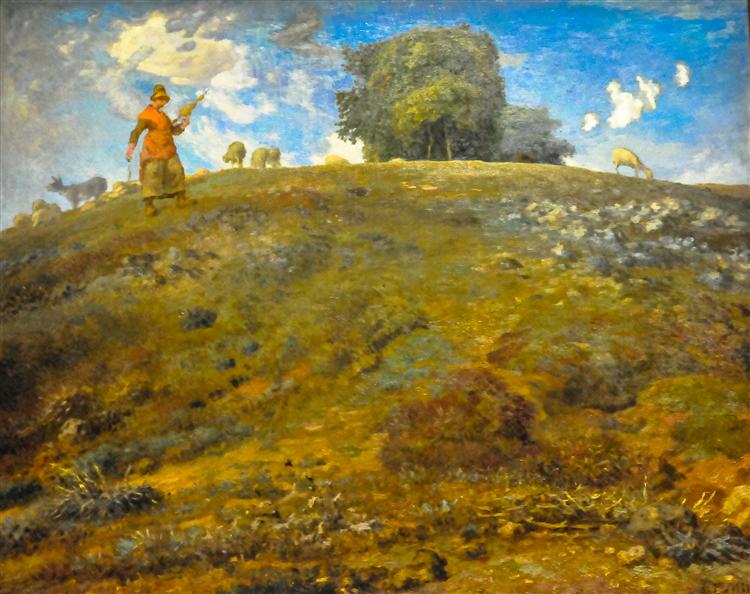Beschreibung
Jean-François Millet's painting "In Auvergne", painted in 1869, is part of the artist's invaluable contribution to the realism movement, characterized by its attention to rural life and the dignity of the working classes. In this piece, Millet captures the idyllic but also demanding landscape of the Auvergne region of France, one of the most mountainous and wild areas of the country that deeply influenced his work. The composition invites us to contemplate the relationship between humans and nature, a recurring theme in his work.
The scene is populated by a group of peasants who appear to be engaged in daily tasks in a natural setting that is both beautiful and arduous. Millet skillfully balances the human figure with the landscape, creating a harmony that reflects the flow of life in the countryside. The figures, though devoid of individualized features, possess a great sense of humanity; they are representations that evoke the sincerity of work on the land. The posture of the peasants, with their robust bodies and traditional clothing, suggests industriousness and connection to the land, an idea that Millet fervently embraced throughout his career.
The use of color in “In Auvergne” is central to the atmosphere of the work. Earthy, warm tones predominate, evoking nature and the fecundity of the countryside. Soft gradations of greens, browns, and yellows suggest not only a vibrant landscape, but also the serenity found in agrarian work. Millet avoids bright or artificial colors; instead, he sticks to a palette that resonates with the authenticity of his subject. The sky is rendered in a subdued, almost melancholic blue, which covers the scene, bringing a sense of calm and continuity to the daily life he depicts.
The arrangement of the figures and their interaction with the surroundings are noteworthy features. The peasants are arranged in a way that makes the work easier to read. One can observe how they look towards a common point or how their movements seem to be synchronized with the rhythm of the earth. This compositional choice not only emphasizes the community but also the interdependence that characterizes rural life.
In Auvergne is not only a portrait of rural life; it is also a testament to Millet's deep appreciation for the dignity of the working man. As in other works such as The Sower or The Gleaners, Millet avoids idealizing the peasantry, taking instead a realistic approach that reveals both the challenge and the beauty of farm work.
The significance of this work and its creator transcends its time. As a pioneer in the depiction of peasant life, Millet has influenced many later artists. His style, which combines careful technique with a deep empathy for his subjects, lays the groundwork for the development of an art that honours the working classes, a legacy that remains relevant and evocative in the contemporary context.
Through “In Auvergne,” Millet does not simply document a moment in time, but delves into a deeper reflection on the connection between humans and their environment. It is a work that invites contemplation, in which viewers can find echoes of their own struggles and connections to the land they inhabit. This painting, in its simplicity and evocative power, remains an enduring testament to the spirit of rural life in France.
KUADROS ©, a famous painting on your wall.
Hand-made oil painting reproductions, with the quality of professional artists and the distinctive seal of KUADROS ©.
Painting reproduction service with satisfaction guarantee. If you are not completely satisfied with the replica of your painting, we will refund 100% of your money.

